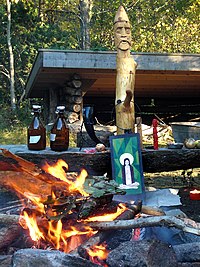
Modern paganism, also known as contemporary paganism[1] and neopaganism,[2] spans a range of new religious movements variously influenced by the beliefs of pre-modern peoples across Europe, North Africa, and the Near East. Despite some common similarities, contemporary pagan movements are diverse, sharing no single set of beliefs, practices, or religious texts.[3] Scholars of religion may study the phenomenon as a movement divided into different religions, while others study neopaganism as a decentralized religion with an array of denominations.
Adherents rely on pre-Christian, folkloric, and ethnographic sources to a variety of degrees; many of them follow a spirituality that they accept as entirely modern, while others claim to adhere to prehistoric beliefs, or else, they attempt to revive indigenous religions as accurately as possible.[4] Modern pagan movements are frequently described on a spectrum ranging from reconstructive, which seeks to revive historical pagan religions; to eclectic movements, which blend elements from various religions and philosophies with historical paganism. Polytheism, animism, and pantheism are common features across pagan theology. Modern pagans can also include atheists, upholding virtues and principles associated with paganism while maintaining a secular worldview. Humanistic, naturalistic, or secular pagans may recognize deities as archetypes or useful metaphors for different cycles of life, or reframe magic as a purely psychological practice.
Contemporary paganism has been associated with the New Age movement, with scholars highlighting their similarities as well as their differences.[5] The academic field of pagan studies began to coalesce in the 1990s, emerging from disparate scholarship in the preceding two decades.
- ^ Doyle White 2016, p. 6.
- ^ Adler 2006, p. xiii.
- ^ Carpenter 1996, p. 40.
- ^ Adler 2006, pp. 3–4
- ^ York 1999.